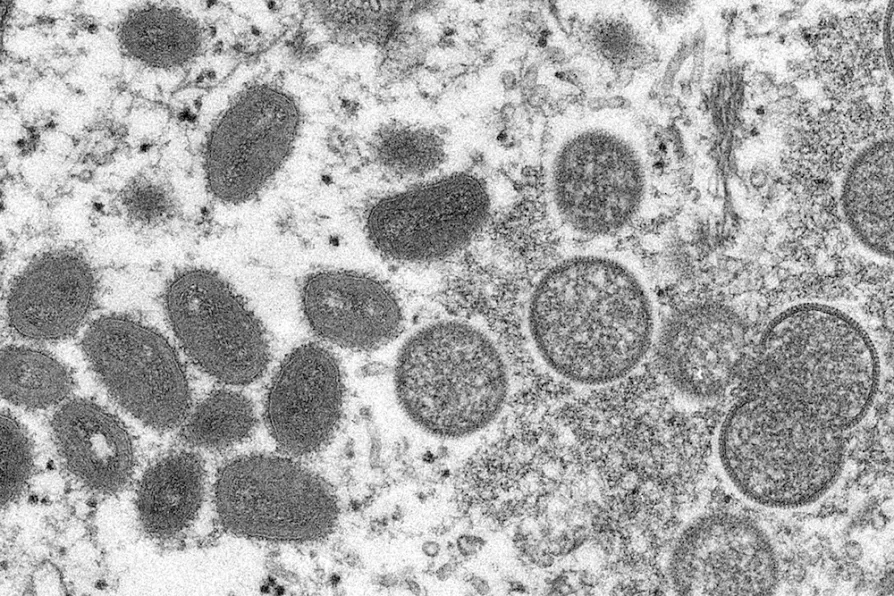KATE CLARK recalls an occasion when the president of the Scottish National Union of Mineworkers might just have saved a Chilean prisoner’s life

 An electron microscope image of mature, oval-shaped monkeypox virions
An electron microscope image of mature, oval-shaped monkeypox virions
IF YOU have been following infectious disease news since the Covid-19 pandemic, you may have already seen that Britain has reached over 300 cases of monkeypox. Monkeypox is a disease caused by the monkeypox virus, which belongs to a small family of viruses that also includes smallpox. In fact, monkeypox is so similar to smallpox that it was only recognised as a distinct pathogen after smallpox was eradicated in the 1970s. Smallpox vaccines are often also quite effective at preventing monkeypox.
Other members of the family include horsepox, cowpox, and camelpox — each named for the animal that they were believed to primarily affect. The viruses are transmitted between infected animals, with rodents acting as a reservoir of infection that can reintroduce the virus into other animal populations. Many of these animal poxes are also “zoonoses” (pronounced zoo-no-sees) since human infection with these viruses is possible through contact with an infected animal.
The exception in this virus family was smallpox due to its ability to only infect humans, with frequently debilitating or fatal consequences. Smallpox was eradicated through a considerable worldwide effort using the technique of “ring” vaccination.
This involves exerting significant effort to find all cases of smallpox that arise and vaccinating anyone that the infected person came into contact with recently — their "ring" of contacts. If vaccination happens quickly enough after infection it can induce immunity before clinical disease occurs. Ring vaccination therefore shuts down chains of transmission if contact tracers are successful at rapidly vaccinating enough of the contacts of known cases.
The successful eradication of smallpox in 1980 brought an end to smallpox vaccination and with it the slow decline of incidental immunity against monkeypox. Monkeypox still remained however, continuing to circulate between rodents and monkeys.
Cases of monkeypox infecting humans continued at a low level, mostly around the Congo Basin. This region includes Cameroon, Central African Republic, Democratic Republic of the Congo (DRC), Republic of the Congo, Equatorial Guinea and Gabon. The disease has displayed seemingly low human-to-human transmission, not spreading far beyond each leap from animal to human. However, the true scale of past transmission is opaque, and apparent confidence in this may be misplaced. Poor health infrastructure meant that cases could have remained untreated or been confused for other rash-causing illnesses such as chickenpox (which belongs to a completely different family of viruses to monkeypox).
The majority of the academic literature on monkeypox derives from its occurrence outside the Congo Basin, first to other countries in Central and Western Africa and then to the United States and Europe. Many infectious diseases such as monkeypox only become noteworthy to the medical establishment or British society when they occur outside of countries where they are simply expected to occur, where they are called “endemic.” Today, this approach implicitly assumes that it is tolerable to us that someone may die of an eminently preventable disease in the Democratic Republic of Congo in a way that is not tolerable in Britain.
As a result, our understanding of monkeypox is fairly piecemeal and imprecise outside of the glimpses afforded by its importation into wealthier countries with wealthier healthcare systems.
A good example of this lack of clarity is that past records show higher case numbers for the more lethal and transmissible Congo Basin genetic clade of the monkeypox virus than for the less deadly West African clade. Until 2019 cases of monkeypox did not require mandatory notification of the World Health Organisation through their Integrated Disease Surveillance and Response reporting system, except for the DRC who implemented their own mandatory reporting system. As a result, it is possible that many cases in the West African clade have gone uncounted.
This relatively less lethal West African clade is the one that, as of June 4 2022, is responsible for 780 confirmed cases in 27 countries outside the Congo Basin. The challenge for public health bodies in these countries is now to respond to an outbreak of a virus for which there are still large gaps in our knowledge, a challenge that has been present for many countries in the Congo Basin for decades.
Uncertain estimates of the transmission of monkeypox prior to this outbreak makes it harder to know if the strain responsible for this outbreak is showing any signs of enhanced transmissibility.
In spite of these uncertainties, everything we know so far suggests that monkeypox is far more containable than Covid-19. In countries where other rash-causing illnesses are rare or non-existent the distinctive sores that monkeypox virus causes in all cases will make case detection easier. It is also hugely beneficial to have existing smallpox vaccines, which are effective against monkeypox and can be repurposed in a ring vaccination strategy.
Genetic analysis of the viruses isolated from monkeypox cases in the US has found that two distinct virus strains are circulating. One strain is similar to the monkeypox cases currently being detected in Europe, whereas the other is far more similar to a strain detected in a US man returning from travel to Nigeria to the US in 2021. This hints that monkeypox transmission may have been underway in countries where its presence is considered less remarkable for some time.
The likely outcome of this monkeypox outbreak will be a commonly seen pattern in infectious diseases: some rich countries will be able to contain their outbreaks and guarantee themselves priority access to smallpox vaccine stocks. Meanwhile, poorer countries will struggle to detect imported cases, to deploy a ring vaccination programme, or to buy vaccines.
A development in public health that has been both accelerated and undermined by Covid-19 has been managing emerging infectious disease through hardening international borders. Protecting sovereign citizens by reactively increasing control over visitors from countries that detect worrying strains failed multiple times as a strategy to prevent the importation of new variants of Covid-19 into Britain. Only complete isolation, as in the cases of Australia and New Zealand, was able fully prevent importation, but proved an unsustainable tactic in the long term.
The temptation here has often been to call for improved disease surveillance in poor countries on the basis that it will prevent us importing any more zoonotic surprises. This is dangerous. Healthcare for the poorest and most exploited people in the world should not be justified in terms of improving the health of people in rich countries. No-one in the Congo Basin should die of monkeypox — because the health of someone in the Congo Basin should be as important to us as the health of someone in Britain.
The scientific consensus remains that destroying animal habitats to meet the ever-increasing resource extraction needs of capital will tend towards further zoonotic spillover events such as Covid-19 and monkeypox. Emerging infectious diseases and climate disintegration will go hand-in-hand as populations of humans and non-human animals alike are displaced.
The ecological Marxist Andreas Malm in his analysis of Covid-19 and the climate emergency puts the problem very succinctly: “Zoonotic spillover of this earth-shattering magnitude should make it clear that defending wild nature against parasitic capital is now human self-defence. But the conscious organisation of such defence is solely up to humans”.

The distinction between domestic and military drones is more theoretical than practical, write ROX MIDDLETON, LIAM SHAW and MIRIAM GAUNTLETT

Nature's self-reconstruction is both intriguing and beneficial and as such merits human protection, write ROX MIDDLETON, LIAM SHAW and MIRIAM GAUNTLETT

A maverick’s self-inflicted snake bites could unlock breakthrough treatments – but they also reveal deeper tensions between noble scientific curiosity and cold corporate callousness, write ROX MIDDLETON, LIAM SHAW and MIRIAM GAUNTLETT
Science has always been mixed up with money and power, but as a decorative facade for megayachts, it risks leaving reality behind altogether, write ROX MIDDLETON, LIAM SHAW and MIRIAM GAUNTLETT














